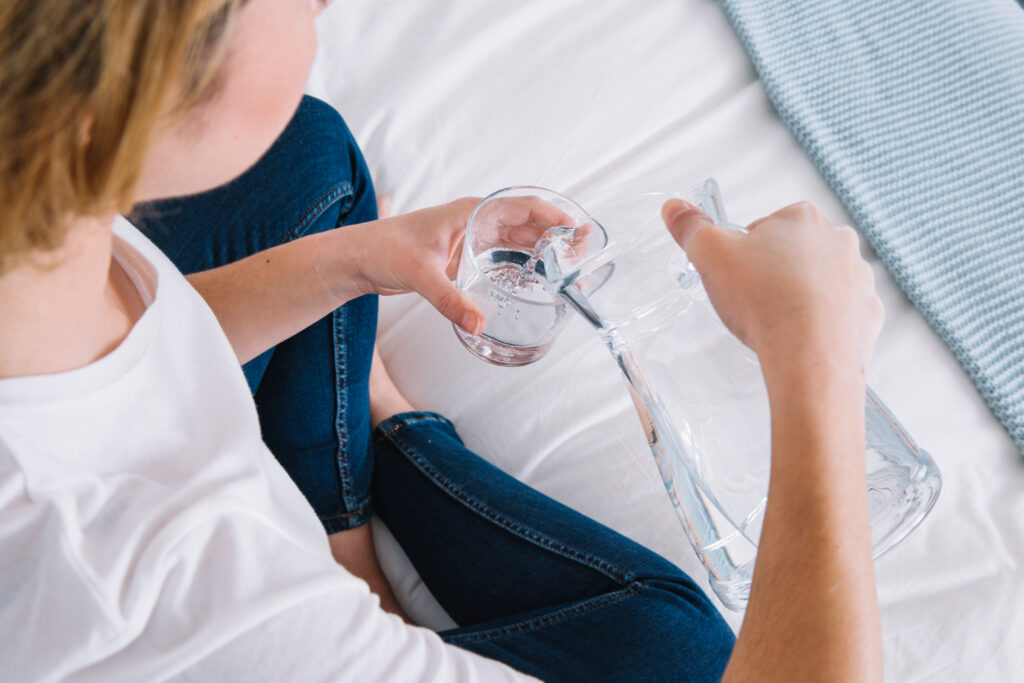
In this article
Water intoxication, also known as water toxicity, occurs when someone consumes an excessive amount of water, diluting essential electrolytes needed for the body to function properly. Although it is rare, water toxicity typically happens in situations where a person over-hydrates, such as after an intense athletic session or due to an underlying health condition.
Symptoms of Water Intoxication
The symptoms of water intoxication resemble those of dehydration, including disorientation, confusion, nausea, and vomiting. If left untreated, these symptoms can become life-threatening and may progress to an altered mental state or loss of consciousness.
What Causes Water Intoxication?
Water intoxication occurs when a person drinks significantly more water than the body requires, negatively impacting the levels of electrolytes like sodium in the blood. Electrolytes are crucial for normal bodily functions, including the nervous and muscular systems and blood pressure regulation.
Normally, the kidneys regulate the balance of water and electrolytes. However, if the kidneys cannot excrete excess fluid quickly enough, electrolyte levels can become dangerously diluted. When sodium levels drop too low, excess water enters the cells, causing them to swell and leading to severe symptoms.
Water intoxication often results from situations involving excessive sweating followed by over-replenishing lost fluids, such as during prolonged exercise or outdoor work in the sun. It can also occur during water-drinking competitions or from excessive thirst due to various reasons.
Risk Factors
Several factors can increase the risk of water intoxication, including health conditions that impair the body’s ability to excrete water, such as kidney or liver disease, heart failure, and diabetes. Certain medications, like antidepressants, vasopressin, and diuretics, can also cause increased thirst and contribute to water intoxication. Additionally, psychedelic substances like MDMA can induce extreme thirst and trigger over-hydration.
Diagnosis
Diagnosing water intoxication can be challenging due to its vague symptoms. Healthcare providers perform a physical examination and review the patient’s medical history. Blood and urine tests are typically ordered to confirm water intoxication. A blood test measures sodium levels, with a normal range being 135-145 milliequivalents per liter (mEq/L). A urine test measures sodium levels in the urine, with 20 mEq/L representing a normal level in a random sample.
Providers may also monitor fluid intake and urine output, along with weight measurements, to detect changes indicating insufficient fluid excretion.
Treatment of Water Intoxication
The goal of treating water intoxication is to prevent complications and restore normal body function. Treatment varies based on symptom severity and the progression of water intoxication. In mild cases, limiting water intake allows the kidneys to adjust and restore fluid-electrolyte balance. This may involve restricting water consumption to less than a quart (or 4 cups) daily for several days.
Other treatment options include monitoring sodium intake, stopping medications that may trigger the issue, and taking diuretics to increase urine production. In severe cases, intravenous (IV) medications may be administered to raise sodium levels slowly and safely, avoiding overcorrection.
Prevention
To avoid water intoxication, it is important to ensure that water intake does not exceed what the kidneys can eliminate. While there are no set guidelines for excessive water intake, general recommendations suggest consuming 15.5 cups of fluids daily for those assigned male at birth and 11.5 cups for those assigned female at birth. This includes fluids from both foods and beverages.
Other tips for preventing water intoxication include:
- Avoid drinking more than 48 ounces of fluid within an hour.
- Stop drinking if you feel suddenly bloated or nauseous.
- Use electrolyte drinks in moderation, especially if you are an endurance athlete.
- Be mindful of hydration needs when running in hot temperatures.
- Monitor urine color, as very light yellow or clear urine may indicate over-hydration.
Complications
Severe water intoxication can lead to hyponatremia, a condition where excessive fluid intake causes dangerously low sodium levels in the bloodstream. If untreated, this can result in serious complications, including brain damage, seizures, coma, and, in rare cases, death.
Ensuring balanced hydration and being mindful of fluid intake can help prevent these severe outcomes
A Quick Review
Water intoxication, or water toxicity, occurs when excessive water consumption dilutes essential electrolytes, leading to symptoms like disorientation, nausea, and vomiting. It’s rare but can be life-threatening if untreated. It often happens after intense exercise or due to health conditions affecting fluid excretion
FAQS
What is water intoxication?
Water intoxication, also known as water toxicity, occurs when someone consumes an excessive amount of water, diluting essential electrolytes like sodium in the body. This can disrupt normal bodily functions and lead to severe health complications.
What are the symptoms of water intoxication?
Common symptoms include disorientation, confusion, nausea, and vomiting. In severe cases, it can lead to an altered mental state, loss of consciousness, seizures, and even death if not treated promptly.
What causes water intoxication?
Water intoxication happens when a person drinks significantly more water than their body needs, overwhelming the kidneys’ ability to excrete the excess fluid. This can occur after intense exercise, during water-drinking competitions, or due to underlying health conditions affecting fluid regulation.
Who is at risk for water intoxication?
People with health conditions like kidney or liver disease, heart failure, or diabetes are at higher risk. Certain medications and drugs, including antidepressants, vasopressin, diuretics, and MDMA, can also increase the risk of water intoxication.











